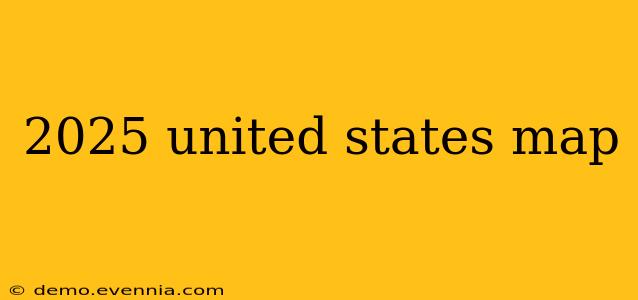The United States is a nation in constant flux, with its demographics, economy, and political landscape shifting year by year. While a definitive map of the US in 2025 is impossible to create – the future is, after all, uncertain – we can explore potential changes based on current trends and projections to paint a picture of what a 2025 US map might look like. This isn't a literal, geographically altered map, but rather an analysis of anticipated shifts in various aspects influencing how we might visualize the country.
Projected Demographic Shifts: A Changing Landscape
One of the most significant changes anticipated by 2025 is further demographic shifts. Current projections suggest continued growth in the populations of certain states, largely driven by migration and birth rates. States in the South and West are expected to see some of the most significant population increases. This growth will likely be reflected in increased urban sprawl, infrastructural developments, and potentially, a shift in political power. Conversely, some states in the Northeast and Midwest may experience slower growth or even population decline, leading to potential economic and social challenges.
Key Areas of Projected Demographic Change:
- Sun Belt States: Texas, Florida, Arizona, and Nevada are anticipated to continue their population booms, potentially leading to increased competition for resources and housing.
- Coastal Areas: Major coastal cities will likely experience continued growth, impacting urban planning and infrastructure development. This includes potential challenges relating to sea level rise and coastal erosion.
- Rural Decline: Many rural communities across the country face ongoing challenges related to population loss, impacting economic vitality and access to services.
Economic Transformations: A More Diverse Economy?
The economic landscape of the US in 2025 is likely to be significantly different from today. The ongoing transition towards a more technology-driven economy is expected to accelerate, leading to growth in sectors such as renewable energy, biotechnology, and artificial intelligence. Simultaneously, some traditional industries might face challenges requiring adaptation and workforce retraining.
Key Economic Projections:
- Technological Hubs: Existing tech hubs like Silicon Valley and Seattle will likely continue to flourish, attracting talent and investment. New tech centers might also emerge in other regions.
- Renewable Energy Growth: Investment in renewable energy sources is expected to increase, potentially leading to the creation of new jobs and economic opportunities in various regions.
- Economic Disparities: Addressing the growing economic disparity between different regions and social groups remains a significant challenge.
Political Landscape: A Shifting Power Dynamic?
The political landscape of the United States in 2025 is inherently difficult to predict. However, based on current trends, we can anticipate continued political polarization and potentially shifts in the balance of power between different states and regions. The previously mentioned demographic shifts will undoubtedly play a crucial role in shaping the political landscape, influencing electoral outcomes and legislative priorities.
Potential Political Shifts:
- Increased Political Polarization: The divide between political parties might continue to deepen, potentially impacting policymaking and governance.
- Shifting Electoral Power: Demographic changes could lead to shifts in the electoral power of certain states, impacting presidential elections and the composition of Congress.
- Focus on Key Issues: Issues such as climate change, healthcare, and economic inequality will likely remain central to political debate and policy discussions.
Conclusion: A Dynamic and Uncertain Future
Creating a precise 2025 map of the United States is impossible. However, by analyzing current trends and projections regarding demographics, economics, and politics, we can develop a more nuanced understanding of the potential changes the country might face. The map of 2025 will likely be characterized by a dynamic mix of growth, challenges, and evolving relationships between different regions and communities. Understanding these potential shifts is crucial for policymakers, businesses, and citizens alike to prepare for the future.

